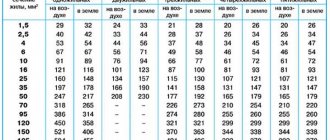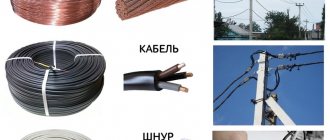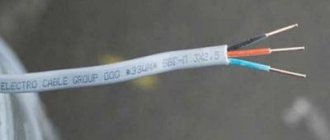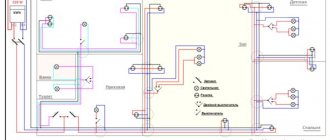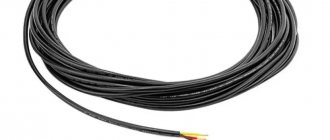The power and current cable cross-section calculator will help you calculate the minimum cable cross-section required for safe operation of electrical wiring to avoid overheating, insulation melting, short circuits and fires.
The calculator allows you to calculate the cable cross-section by current or power, based on the parameters of the total load and incoming voltage. This takes into account the installation conditions, wire manufacturing materials, possible voltage losses and conductor selection criteria. The functionality of the section also allows you to calculate the maximum current and load on a conductor with specified parameters and select protection devices (circuit breakers, differential circuit breakers and RCDs).
How to calculate the cable cross-section:
- Indicate the source data (current or power), voltage, conductor material (copper or aluminum), type of wiring (open or closed in a pipe), number of wires (when laying communications in a pipe);
- Note additional conditions (wire length, permissible losses);
- Click on the “Calculate” button and save the resulting parameters.
The cable cross-section calculator works online and offline. Please note: it is for guidance only and cannot guarantee 100% accuracy of the calculations. However, the more valid data you enter into the appropriate fields, the higher the match rate will be.
Related regulatory documents:
- PUE-7 “Rules for electrical installations”
- SP 76.13330.2016 “Electrical devices”
- GOST R 50571.5.52-2011/IEC 60364-5-52:2009 “Low-voltage electrical installations. Selection and installation of electrical equipment"
- GOST 31946-2012 “Self-supporting insulated and protected wires for overhead power lines”
- GOST 31947-2012 “Wires and cables for electrical installations for rated voltage up to 450/750 V”
- GOST 6323-79 “Wires with polyvinyl chloride insulation for electrical installations”
- GOST 31996-2012 “Power cables with plastic insulation for a rated voltage of 0.66; 1 and 3 kV"
- GOST 433-73 “Power cables with rubber insulation”
How to calculate cable cross-section by power: formula
Before choosing a cable cross-section based on power, you need to calculate its total value and make a list of electrical appliances located in the territory to which the cable is laid. The power must be indicated on each device; the corresponding units of measurement will be written next to it: W or kW (1 kW = 1000 W). Then you will need to add up the power of all equipment and get the total.
1️⃣ First step. The total power of all electrical appliances that can be connected to the network is calculated:
Psum = (P1 + P2 + .. + Pn) × Kс
- P1, P2 .. – power of electrical appliances, W;
- Kc – demand coefficient (probability of simultaneous operation of all devices), default is 1.
2️⃣ Second step. Then the rated current in the circuit is determined:
I = Psum / (U × cos ϕ)
- Psum – total power of electrical appliances;
- U – network voltage;
- cos ϕ – power factor (characterizes power losses), default is 0.92.
3️⃣ Third step. At the last stage, tables are used in accordance with the PUE (Electrical Installation Rules).
Table of copper cable cross-section by current according to PUE-7
| Conductor cross-section, mm2 | Current, A, for wires laid | |||||
| open | in one pipe | |||||
| two single-core | three single-core | four single-core | one two-wire | one three-wire | ||
| 0.5 | 11 | – | – | – | – | – |
| 0.75 | 15 | – | – | – | – | – |
| 1 | 17 | 16 | 15 | 14 | 15 | 14 |
| 1.2 | 20 | 18 | 16 | 15 | 16 | 14.5 |
| 1.5 | 23 | 19 | 17 | 16 | 18 | 15 |
| 2 | 26 | 24 | 22 | 20 | 23 | 19 |
| 2.5 | 30 | 27 | 25 | 25 | 25 | 21 |
| 3 | 34 | 32 | 28 | 26 | 28 | 24 |
| 4 | 41 | 38 | 35 | 30 | 32 | 27 |
| 5 | 46 | 42 | 39 | 34 | 37 | 31 |
| 6 | 50 | 46 | 42 | 40 | 40 | 34 |
| 8 | 62 | 54 | 51 | 46 | 48 | 43 |
| 10 | 80 | 70 | 60 | 50 | 55 | 50 |
| 16 | 100 | 85 | 80 | 75 | 80 | 70 |
| 25 | 140 | 115 | 100 | 90 | 100 | 85 |
| 35 | 170 | 135 | 125 | 115 | 125 | 100 |
| 50 | 215 | 185 | 170 | 150 | 160 | 135 |
| 70 | 270 | 225 | 210 | 185 | 195 | 175 |
| 95 | 330 | 275 | 255 | 225 | 245 | 215 |
| 120 | 385 | 315 | 290 | 260 | 295 | 250 |
| 150 | 440 | 360 | 330 | – | – | – |
| 185 | 510 | – | – | – | – | – |
| 240 | 605 | – | – | – | – | – |
| 300 | 695 | – | – | – | – | – |
| 400 | 830 | – | – | – | – | – |
Table of cross-section of aluminum cable by current according to PUE-7
| Conductor cross-section, mm2 | Current, A, for wires laid | |||||
| open | in one pipe | |||||
| two single-core | three single-core | four single-core | one two-wire | one three-wire | ||
| 2 | 21 | 19 | 18 | 15 | 17 | 14 |
| 2.5 | 24 | 20 | 19 | 19 | 19 | 16 |
| 3 | 27 | 24 | 22 | 21 | 22 | 18 |
| 4 | 32 | 28 | 28 | 23 | 25 | 21 |
| 5 | 36 | 32 | 30 | 27 | 28 | 24 |
| 6 | 39 | 36 | 32 | 30 | 31 | 26 |
| 8 | 46 | 43 | 40 | 37 | 38 | 32 |
| 10 | 60 | 50 | 47 | 39 | 42 | 38 |
| 16 | 75 | 60 | 60 | 55 | 60 | 55 |
| 25 | 105 | 85 | 80 | 70 | 75 | 65 |
| 35 | 130 | 100 | 95 | 85 | 95 | 75 |
| 50 | 165 | 140 | 130 | 120 | 125 | 105 |
| 70 | 210 | 175 | 165 | 140 | 150 | 135 |
| 95 | 255 | 215 | 200 | 175 | 190 | 165 |
| 120 | 295 | 245 | 220 | 200 | 230 | 190 |
| 150 | 340 | 275 | 255 | – | – | – |
| 185 | 390 | – | – | – | – | – |
| 240 | 465 | – | – | – | – | – |
| 300 | 535 | – | – | – | – | – |
| 400 | 645 | – | – | – | – | – |
In the Electrical Installation Rules, 7th edition, there are no tables of cable cross-section by power, there is only data on current strength. Therefore, when calculating sections using load tables on the Internet, you risk getting incorrect results.
Basic Rules
When laying electrical networks in residential buildings, garages, and apartments, rubber or PVC insulated cables designed for a voltage of no more than 1 kV are most often used. There are brands that can be used outdoors, indoors, in walls (grooves) and pipes. Usually this is a VVG or AVVG cable with different cross-sectional areas and number of cores. PVA wires and SHVVP cords are also used to connect electrical appliances.
After calculation, the maximum permissible cross-section value is selected from a number of cable grades.
Basic recommendations for choosing a cross-section are found in the Electrical Installation Rules (PUE). The 6th and 7th editions have been released, which describe in detail how to lay cables and wires, install protection, distribution devices and other important points.
For violation of the rules, administrative fines are provided. But the most important thing is that violation of the rules can lead to failure of electrical appliances, fire of wiring and serious fires. Fire damage is sometimes measured not in monetary terms, but in human casualties.
Selecting cable cross-section based on current strength: calculation formula
The amount of current passing through a conductor depends on the length, width, resistivity of the latter and on temperature. When heated, the electric current decreases.
1️⃣ First step. The calculation is carried out in exactly the same way, that is, first the total power of all electrical appliances that can be connected to the network is calculated:
Psum = (P1 + P2 + .. + Pn) × Kс
- P1, P2 .. – power of electrical appliances, W;
- Kc – demand coefficient (probability of simultaneous operation of all devices), default is 1.
2️⃣ Second step. Then the rated current in the circuit is determined:
I = Psum / (U × cos ϕ)
- Psum – total power of electrical appliances;
- U – network voltage;
- cos ϕ – power factor (characterizes power losses), default is 0.92.
3️⃣ Third step. At the last stage, the same tables are used, according to the PUE (Electrical Installation Rules), which are located above.
Power
The cable cross-section for power is also calculated using a general load table. But during the installation of networks at large facilities, it does not guarantee the accuracy of calculations, since voltage drop plays a role with long cable lengths. That is, if the consumer is significantly removed from the power source, the actual voltage will be lower than the rated voltage. As we remember, current is the result of dividing resistance by voltage (I = P/U). Accordingly, as the voltage decreases, the current will increase. Along with it, the required cross-sectional area of the cable will increase (for a larger load, a thicker cable is needed). For clarity, below is a table for calculating cable cross-section by power and length, adjusted for voltage drop.
When installing an electrical network in an apartment or private house, these deviations can be neglected - they will not have a noticeable impact on the operation of the wiring, since they will be compensated for by rounding up.
Calculation of cable cross-section by length: formula
The cable length affects the voltage loss. Thus, the voltage at the end of the conductor may decrease and be insufficient to operate the electrical appliance. For household electrical networks, these losses can be neglected. It will be enough to take a cable 10-15 cm longer. This reserve will be used for switching and connection. If the ends of the wire are connected to the shield, then the spare length should be even greater, since circuit breakers will be connected.
1️⃣ First step. First, the rated current in the circuit is determined:
I = Psum / (U × cos ϕ)
- Psum – total power of electrical appliances;
- U – network voltage;
- cos ϕ – power factor (characterizes power losses), default is 0.92.
2️⃣ Second step. Then the conductor resistance is calculated:
R = dU/I
- dU – voltage loss, no more than 5% (0.05);
- I – current strength.
3️⃣ Third step. The cross-section of the current-carrying conductor is calculated using the formula:
S = ρ × L/R
- ρ – metal resistivity, copper (0.0175), aluminum (0.028);
- L – conductor length;
- R – conductor resistance.
Influence of operating parameters on calculation
To determine how thick a cable should be to lay functional and safe wiring, you can focus on the main operating indicators of the electrical network (voltage, current, power consumption). However, each of these methods has small features that must be taken into account. Let's look at them separately.
Voltage
When calculating the cable cross-section by voltage, the type of network based on the number of phases is of key importance. As we know, a standard household network has 1 power phase with a voltage of 220 volts, and in industrial activities and at highly loaded facilities a three-phase network is used - with a voltage of 380 volts. The structure of the power cable is also different:
- in single-phase – 3 wires: phase, neutral, ground;
- in three-phase - 5 cores: 3 phases, zero, grounding.
This imposes certain features on the installation of the electrical network related to the distribution of power to machines and leased lines. For example, from the power panel of a private house there is one branch for lighting and supplying electricity to the garage, the power consumption of which is 18 kilowatts. And this is where the difference comes in:
- In a single-phase network, the cable will take on the entire load of the branch, equal to 18 kW. That is, when using copper wire, its cross-section should be 16 or 25 mm2 (for hidden and open wiring).
- In a three-phase network, the cable will consist of three supply wires, each of which will be under a load of 6.6 kW. That is, the cross-sectional area of each of them can be 1 mm2, and the total - 3mm2.
For example, we are laying an electrical network in an apartment connected to a single-phase network with a voltage of 220V. To power an electric stove with a rated power of 5 kW, a separate branch with automation will be installed from the distribution panel. According to the table, for this you need to use a copper cable with a cross-sectional area of 2.5 mm2. It is better not to use aluminum wires at all to power such devices - their properties can change for the worse under the influence of heavy load.
Current strength
To find out which wires are suitable for use on a certain section of the circuit, you can make calculations based on current strength. In this situation, some electricians make an approximate calculation, believing that there should be 10A of current per square millimeter of cross-section, but this method is not very accurate, since it is only suitable for single-phase networks and cables with a cross-sectional area of up to 6 mm2. Therefore, we will look at how to correctly and accurately select a cable based on the rated current.
Most often, their rated power is indicated on the body of electrical appliances or in the technical documentation, with the help of which we can calculate the power and, therefore, the load. By adding up the current loads of all electrical appliances, we get the total power. Based on this value, you will need to select a wire. For example, a section of the network includes two 100W and four 40W lamps, as well as a 1200W microwave and a 2200W electric kettle. The total load power in such a circuit will be 3760 W or 3.76 kW. To calculate the cable cross-section you will need a standard formula for finding the current strength.
I= P/U
P – resistance (total power); U – network voltage; I – current strength
I= 3760W/220V= 17.09 A
The current load on our network section is 17.09A. The load table used in the methods above will help us in choosing the appropriate cable. We turn to it and see that in a single-phase network with a voltage of 220V, you can use a copper cable with a cross-section of 1.5 mm2 or an aluminum cable with a cross-section of 2.5 mm2. For a network with a voltage of 380V, these indicators are similar - a significant difference in the required cable thickness between three- and two-phase networks becomes noticeable only with a load above 25A.
Do not forget that the selection of conductors based on the long-term permissible current must be rounded up. If, for example, the total load is 22.5 A, you should take a cable with a cross-section not lower than this value. According to the table, this will be 2.5 mm2 for copper wires and 4 mm2 for aluminum. This ratio is natural for these two materials, since copper has a higher throughput.
How to choose cable sections?
There are several more criteria that the cross-section of the wires used must meet:
- Length of cable
. The longer the wire, the greater the current loss observed in it. This again occurs as a result of an increase in resistance, which increases as the length of the conductor increases. This is especially noticeable when using aluminum wiring. When using copper wires to organize electrical wiring in an apartment, the length, as a rule, is not taken into account - the standard margin of 20–30% (for hidden wiring) is more than enough to compensate for possible increases in resistance associated with the length of the wire. - Type of wires used
. There are 2 types of conductors used in household electricity supply - copper or aluminum based. Copper wires are of better quality and have less resistance, but aluminum wires are cheaper. In full compliance with the standards, aluminum wiring copes with its tasks no worse than copper, so you need to carefully weigh your choice before purchasing a wire. - Electrical panel configuration
. If all the wires supplying consumers are connected to one circuit breaker, then it will be the weak point in the system. A heavy load will lead to heating of the terminal blocks, and non-compliance with the rating will lead to its constant operation. It is recommended to divide the electrical wiring into several “beams” with the installation of a separate machine.
In order to determine the exact data for choosing the cross-section of electrical wiring cables, it is necessary to take into account any, even the most insignificant parameters, such as:
- Type and type of insulation of electrical wiring;
- Length of sections;
- Laying methods and options;
- Features of temperature conditions;
- Humidity level and percentage;
- The maximum possible value of superheat;
- The difference in the powers of all current receivers belonging to the same group. All these and many other indicators can significantly increase the efficiency and benefits of energy use on any scale. In addition, correct calculations will help avoid cases of overheating or rapid abrasion of the insulating layer.
In order to correctly determine the optimal cable cross-section for any human household needs, it is necessary in all general cases to use the standardized following rules:
- for all sockets that will be installed in the apartment, it is necessary to use wires with an appropriate cross-section of 3.5 mm²;
- for all spotlighting elements, it is necessary to use electrical wiring cables with a cross-section of 1.5 mm²;
- As for high-power devices, cables with a cross-section of 4-6 mm² should be used.
If some doubts arise during the installation or calculation process, it is better not to act blindly. The ideal option would be to refer to the appropriate table of calculations and standards.
Table: Cable cross-section for closed and open wiring
Video: How to choose a wire cross-section?
Calculation methods
In this article we will not consider the issue of creating an electrical network diagram and dividing consumers into groups. It is enough to note that these days it is generally accepted that devices with high power consumption are placed on a separate line from each other, as well as from groups of sockets and lighting fixtures. Therefore, as a rule, thicker wires are used for them.
And in order to choose to calculate the wire cross-section for an apartment, they turn to several methods:
- according to the table of correspondence of load to core thickness;
- by length (using the formula);
- by power consumption;
- by other performance indicators (voltage or current).
Using formula
The cross-section of the cable is the cross-sectional area of the conductor. If a multicore cable is used to supply the phase, then the cross-section is taken as the sum of these areas.
To find the calculated value of the cable cross-section, you can express it from the wire resistance formula, according to which:
R= (p*l)/S
Here p means resistivity, l is the length of the wire, and S is its cross-sectional area. Recall that the area of a circle is equal to the square of its diameter multiplied by 0.758 (S = 0.758d2). With a known value of the wire thickness (that is, the diameter of the transverse circle), we reduce the formula to the following form:
R= (p*l)/(0.758*d^2) d – core diameter
The value of p depends on the metal from which the wire is made; its value can be found in reference books.
Using this formula, we can find out what maximum resistance a wire of a given thickness is designed for, that is, determine the safe load, and use this information to design a home electrical network. It is worth recognizing that this method of calculating the cross-section is relatively complex and cumbersome, especially if the apartment will have many power lines with different power consumption. We present it here for a more complete understanding of how the calculation occurs. Moreover, the performance characteristics of all types of wires have long been known, which means you don’t have to suffer (and avoid possible mistakes), but use already known data summarized in a convenient table.
Using a table
A table of loads and cables corresponding to its value is a much more convenient way to find the calculated cross-sectional area. The most important indicator in this table is the resistance of the wire material. Electrical cables are most often made of copper and aluminum. The latter have lower performance characteristics and for this reason have recently been increasingly rejected by professionals as less safe and reliable. Despite this, aluminum wires are still very often used in home electrical systems. Therefore, the PES (electrical installation rules) table for selecting a cross-section contains columns with values for both metals.
In the table below, the calculated cross-sectional area is determined by current and power, since these two parameters are interrelated and are calculated using a general formula. Obviously, it is much more convenient than the method described earlier - there is no need to make complex calculations based on the diameter of the cores. Here it is enough to know the total load that will be applied to the wires and immediately see what their thickness should be. Please remember that for safety and reliability reasons, you should always round up the cross-sectional value.
Open and closed wiring
Depending on the placement, wiring is divided into 2 main types: closed and open.
Today, hidden wiring is installed in apartments. Special recesses are created in the walls and ceilings to accommodate cables. After installing the conductors, the recesses are plastered. Copper wires are used. Everything is planned in advance, because over time, to build up electrical wiring or replace elements, you will have to dismantle the finishing. For hidden finishing, wires and cables that have a flat shape are often used.
When laid open, the wires are installed along the surface of the room. Advantages are given to flexible conductors that have a round shape. They are easy to install in cable channels and pass through the corrugation. When calculating the load on the cable, the method of laying the wiring is taken into account.
What are the dangers of incorrectly installed electrical wiring: how hidden risks manifest themselves
Since the beginning of the summer season, a new neighbor brought his friend Andrei to me. He has a request: help resolve the issue with low voltage in his area. He is particularly concerned about the low levels in the garage where he has set up his electrical workshop.
Let's go have a look and check. Voltage is supplied to the input panel of a private house. My pocket multimeter showed 203 volts, which is generally acceptable for rural areas.
But then miracles began. On its large territory there are several outbuildings. They are connected in a daisy chain: one to the other. The garage is at the very end.
The total length of the highway exceeds one hundred meters. The connection was made with what was at hand: 1.5 mm square copper wire, and individual sections between buildings were powered even with 2.5 square meter aluminum strands.
This area has increased resistance. It creates a voltage drop at the entrance to the garage of up to 185 volts. And this is no longer enough for the normal operation of electric motors of various machines.
Andrey’s losses in the area from his house to his workshop amounted to 18 volts. He was going to buy a voltage stabilizer for the garage, and I explained to him that this could not be done for the following reasons:
- the stabilizer will raise the voltage level at its output and the power consumption of the machines will increase even more;
- This will further increase the load on the wiring.
In this situation, an additional voltage drop will occur at the input to the stabilizer, which will entail:
- disabling it from protection;
- or an emergency situation occurs in the wiring due to its overload and overheating.
Unnecessary voltage losses can only be eliminated by correct selection of the cross-section of the power cable, taking into account the transmitted power and its reliable installation.


